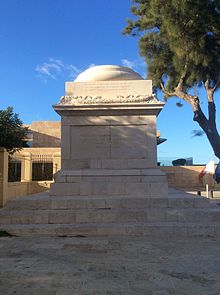Frederick Cavendish Ponsonby
The Honourable Sir Frederick Ponsonby | |
|---|---|
Knight Commander of the Order of the Bath |
Early life and education
Ponsonby was the second of three sons of Frederick Ponsonby, Viscount Dungannon (who succeeded as the 3rd Earl of Bessborough in 1793), and Henrietta Ponsonby, Countess of Bessborough. He was the brother of John Ponsonby, 4th Earl of Bessborough, and William Ponsonby, 1st Baron de Mauley, and his sister was the "notorious" Lady Caroline Lamb, who married the Prime Minister Viscount Melbourne.[1]
Early career
Ponsonby joined the army as a
He fought well at
After the
He led the 12th Light Dragoons to disperse some of the broken French infantry after the
Waterloo Campaign
During the
Ponsonby was wounded in both arms, and knocked off his horse by another sabre cut. A French lancer saw him move where he lay and stabbed him in the back with his lance, exclaiming "Tu n'es pas mort, coquin" (You're not dead, you rascal).
Later career

Ponsonby went on half-pay on 26 August 1820, and was appointed "inspecting field officer" in the
In 1838, Ponsonby's Column was erected in Valletta in honour of the governor. It was destroyed by lightning in 1864.[14]
Family
On 16 March 1825, Ponsonby married Lady Emily Charlotte Bathurst (died 1877), the youngest daughter of Henry Bathurst, 3rd Earl Bathurst. They had three sons and three daughters:[15][16]
- Sir Henry Frederick Ponsonby (1825–1895), married Mary Elizabeth Bulteel on 30 April 1861
- Alberta Victoria Ponsonby (6 May 1862 – 15 October 1945), married Major-General William Montgomery of Grey Abbey, son of Hugh Montgomery and Lady Charlotte Herbert
- Magdalen Ponsonby (24 June 1864 – 1 July 1934)
- John Ponsonby (25 March 1866 – 26 March 1952), married Mary Robley, daughter of Thomas Robley
- Frederick Edward Grey Ponsonby (16 September 1867 – 20 October 1935), married Victoria Kennard, daughter of Edmund Hegan Kennard and Agnes Hegan, and had issue
- Arthur Augustus William Harry Ponsonby (16 February 1871 – 24 March 1946), married Dorothea Parry, daughter of Sir Hubert Parry, 1st Baronet, and Lady Elizabeth Herbert, and had issue
- Lieutenant Colonel Arthur Edward Valette (3 December 1827 – 16 June 1868), married Catina Dahl
- Georgina Melita Maria Ponsonby (16 February 1829 – 18 February 1895), unmarried
- Harriet Julia Frances Ponsonby (27 October 1830 – 30 June 1906)
- Selina Barbara Wilhelmina Ponsonby (20 January 1835 – 22 July 1919), married William Windham Baring on 2 January 1862, without issue
- Frederick John Ponsonby (21 March 1837 – 3 February 1894), took holy orders and died unmarried
Notes
- ISBN 0-9711966-2-1.
- ^ a b Lloyd & Falkner 2004, ¶ 1.
- ^ a b Lloyd & Falkner 2004, ¶ 2.
- ^ Lloyd & Falkner 2004, ¶ 3.
- ^ Andrew Roberts (2001). Napoleon and Wellington (Weidenfeld & Nicolson), pp. 136–7.
- ^ a b Lloyd & Falkner 2004, ¶ 4.
- ^ a b Dalton 1904, p. 76.
- ^ Paul Douglas (2004). Lady Caroline Lamb (Macmillan), p. 171.
- ^ Paul Douglas (2004). Lady Caroline Lamb (Macmillan), pp. 171–2.
- ^ Alice Marie Crossland (2016). Wellington's Dearest Georgy (Universe Press), p. 88.
- ^ a b Creasy 1877, Chapter XV. Battle of Waterloo, A.D. 1815.
- ^ a b Lloyd & Falkner 2004, ¶ 6.
- ^ Bromley & Bromley 2015, p. 1825.
- ^ Simpson, Donald H. (1958). "Some public monuments of Valletta 1800–1955" (PDF). Melita Historica. 2 (3): 156–157. Archived from the original (PDF) on 27 March 2017. Retrieved 4 September 2015.
- ^ Lloyd & Falkner 2004, ¶ 5.
- ^ Burke's Peerage, Hon. Frederick Cavendish Ponsonby (p. 126)
 This article incorporates text from a publication now in the public domain: "Ponsonby, Frederic Cavendish". Dictionary of National Biography. London: Smith, Elder & Co. 1885–1900.
This article incorporates text from a publication now in the public domain: "Ponsonby, Frederic Cavendish". Dictionary of National Biography. London: Smith, Elder & Co. 1885–1900.
References
- Bromley, Janet; Bromley, David (2015). Wellington's Men Remembered Volume 2: A Register of Memorials to Soldiers Who Fought in the Peninsular War and at Waterloo- Volume II: M to Z. Pen and Sword. ISBN 978-1-4738-5768-1.
- Creasy, Sir Edward (1877), The Fifteen Decisive Battles of the World: from Marathon to Waterloo, Richard Bentley & Son, ISBN 0-306-80559-6
- Dalton, Charles (1904). The Waterloo roll call. With biographical notes and anecdotes. London: Eyre and Spottiswoode.
- doi:10.1093/ref:odnb/22493. (Subscription or UK public library membership required.) The first edition of this text is available at Wikisource: Lloyd, Ernest Marsh (1896). . In Lee, Sidney (ed.). Dictionary of National Biography. Vol. 46. London: Smith, Elder & Co. pp. 80–81. . ONDB Endnotes:
- A. Ponsonby, Henry Ponsonby, Queen Victoria's private secretary: his life from his letters (1942)
- J. Ponsonby, The Ponsonby family (1929)
- Earl of Bessborough and A. Aspinall, eds., Lady Bessborough and her family circle (1940)
- Army List
- H. T. Siborne, ed., Waterloo letters (1891)
- GM, 2nd ser., 7 (1837)
- The dispatches of ... the duke of Wellington ... from 1799 to 1818, ed. J. Gurwood, 13 vols. in 12 (1834–9)
- Hart's Army List · W. F. P. Napier, History of the war in the Peninsula and in the south of France, 3rd edn, 6 vols. (1834–40)
- D. Howarth, A near run thing (1967)
- R. H. Gronow, The reminiscences of Captain Gronow, 4 vols. (1861–6)
- E. A. Gray, Trumpet of glory (1985)
- Cokayne, The Complete Peerage
- Burke, Peerage
Further reading
- Haythornthwaite, Philip J. Uniforms of Waterloo. Hippocrene, 1974.
External links
- Wood, James, ed. (1907). . The Nuttall Encyclopædia. London and New York: Frederick Warne.
- Hansard 1803–2005: contributions in Parliament by Frederick Cavendish Ponsonby
